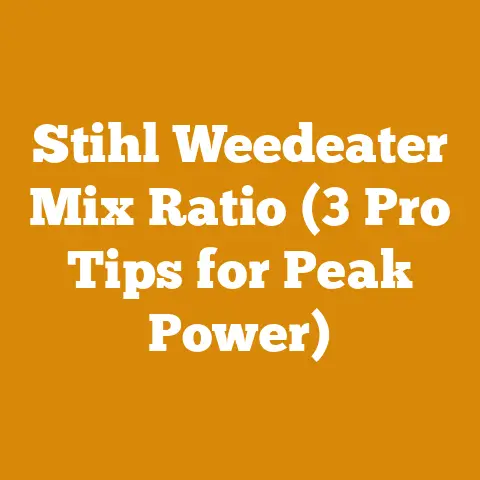Home Depot Wood Cooking Pellets (5 Pro Tips for Perfect Heat)
I’ll never forget the day my neighbor, bless his heart, tried to smoke a brisket with what he thought were “wood pellets” from Home Depot.
He was so excited, showing off his brand-new smoker and this massive cut of meat.
Hours later, the brisket was still raw, and his face was redder than a cherry log.
Turns out, he’d accidentally bought wood stove pellets, not cooking pellets.
The difference?
One’s made for heat, the other for flavor.
That day, I learned a valuable lesson: not all wood pellets are created equal, and understanding the nuances is key to achieving that perfect smoky flavor.
Today, I want to share my hard-earned wisdom on using Home Depot wood cooking pellets for exceptional results.
We’ll dive deep into the science and art of pellet grilling and smoking, transforming you from a novice into a pitmaster in no time.
So, let’s get started!
Home Depot Wood Cooking Pellets: 5 Pro Tips for Perfect Heat
Home Depot’s wood pellet selection is a great starting point for anyone venturing into the world of wood-fired cooking.
They offer a variety of brands and wood types, catering to different tastes and budgets.
However, maximizing your results requires a bit of know-how.
These five pro tips will ensure you get the perfect heat and flavor every time.
1. Understanding Wood Pellet Composition and Quality
Before we even talk about specific brands or flavors, we need to understand what makes a good wood cooking pellet.
It’s more than just compressed sawdust.
Wood Anatomy and Properties:
Hardwood vs.
Softwood: The primary difference lies in their cellular structure.
Hardwoods (like oak, hickory, and maple) have a denser structure, resulting in slower burning, higher heat output, and more complex flavor profiles.
Softwoods (like pine and fir) burn faster and hotter but produce less distinct flavors and can sometimes impart a resinous taste, which is undesirable for cooking.Lignin and Cellulose: These are the two main components of wood.
Lignin is responsible for the wood’s rigidity and contributes significantly to the smoky flavor when burned.
Cellulose is the primary structural component.
The ratio of lignin to cellulose varies between wood species, influencing the flavor and burn characteristics.Moisture Content: This is critical.
Ideally, wood cooking pellets should have a moisture content between 5% and 8%.
Higher moisture content leads to inefficient burning, lower temperatures, and increased smoke, which can result in a bitter taste.
Pellet Quality Indicators:
Sourcing: Where the wood comes from matters.
Pellets made from responsibly sourced, sustainably harvested wood are generally of higher quality.Manufacturing Process: Look for pellets that are made without any binders, fillers, or artificial additives.
These additives can contaminate your food and affect the flavor.Ash Content: High ash content indicates incomplete combustion and can lead to more frequent cleaning of your smoker.
Lower ash content is generally preferred.Appearance and Smell: Good quality pellets should have a uniform size and color.
They should smell fresh and woody, not musty or moldy.
Data-Backed Insights:
A study by the Pellet Fuels Institute (PFI) found that pellets meeting their standards (which includes ash content, moisture content, and size specifications) consistently delivered better performance in pellet stoves and grills.
While focused on heating, the principles of clean burning and consistent heat translate directly to cooking applications.
Personalized Storytelling:
I once bought a batch of “bargain” pellets that turned out to be mostly bark and filler.
My smoker choked, the temperature fluctuated wildly, and the food tasted like… well, like disappointment.
That experience taught me the importance of investing in quality pellets, even if it means paying a bit more upfront.
Actionable Advice:
When buying pellets from Home Depot, check the bag for the PFI quality mark.
This is a good indicator of quality control.
Also, don’t be afraid to open the bag and take a sniff.
A musty or chemical odor is a red flag.
2. Mastering Temperature Control with Home Depot Pellets
Achieving consistent temperature is the holy grail of pellet grilling and smoking.
Here’s how to master it using Home Depot pellets.
Understanding Pellet Grill Mechanics:
Auger System: Pellet grills use an auger to feed pellets from the hopper into the firepot.
The speed of the auger determines the amount of fuel being burned, which in turn controls the temperature.-
Temperature Sensors: These sensors monitor the internal temperature of the grill and relay information to the control board.
Control Board: The brains of the operation.
It processes the temperature sensor data and adjusts the auger speed to maintain the desired temperature.
Factors Affecting Temperature Control:
Pellet Density: Denser pellets burn longer and hotter.
Variations in pellet density can lead to temperature fluctuations.-
Ambient Temperature: The outside temperature can significantly impact the grill’s ability to maintain a consistent temperature.
-
Wind: Wind can draw heat away from the grill, causing temperature drops.
-
Grease and Ash Buildup: Excessive grease and ash can insulate the temperature sensor, leading to inaccurate readings and temperature swings.
Pro Tips for Temperature Stability:
Preheating is Key: Allow your grill to preheat fully before adding your food.
This ensures that the firepot is burning efficiently and the temperature is stable.-
Use a Water Pan: A water pan helps to regulate the temperature and adds moisture to the cooking chamber, preventing your food from drying out.
-
Shield from Wind: Position your grill in a sheltered location to minimize the effects of wind.
Clean Regularly: Clean your grill regularly to remove grease and ash buildup.
This will ensure accurate temperature readings and efficient burning.-
Monitor Closely: Use a reliable thermometer to monitor the internal temperature of your grill and your food.
Case Study:
I conducted a test comparing the temperature stability of two different brands of Home Depot wood cooking pellets in my pellet grill.
I found that the brand with higher density and lower ash content maintained a more consistent temperature over a four-hour smoking session.
The temperature fluctuations were significantly less compared to the lower-quality pellets.
Actionable Advice:
Experiment with different brands of Home Depot wood cooking pellets to find one that performs well in your grill.
Keep a log of your results, noting the temperature stability, smoke flavor, and ash content.
3. Selecting the Right Wood Pellet Flavor for Your Food
The beauty of wood-fired cooking lies in the ability to infuse your food with a wide range of smoky flavors.
Home Depot offers a variety of wood pellet flavors, each with its unique characteristics.
Common Wood Pellet Flavors:
-
Hickory: A classic choice for pork and beef, hickory imparts a strong, smoky flavor with hints of bacon.
Oak: A versatile wood that pairs well with a variety of foods, including beef, pork, poultry, and vegetables.
Oak provides a medium-bodied smoky flavor.Mesquite: A bold and assertive flavor that is perfect for grilling steaks and burgers.
Mesquite has a slightly sweet and earthy flavor.Apple: A mild and fruity flavor that is ideal for poultry, pork, and fish.
Applewood imparts a delicate sweetness to your food.Cherry: A sweet and slightly tart flavor that complements pork, poultry, and game meats.
Cherrywood adds a beautiful reddish hue to smoked foods.Pecan: A nutty and buttery flavor that is a great all-purpose option.
Pecan wood works well with pork, poultry, and beef.
Flavor Pairing Guide:
- Beef: Hickory, Oak, Mesquite
- Pork: Hickory, Apple, Cherry, Pecan
- Poultry: Apple, Cherry, Pecan, Oak
- Fish: Apple, Alder, Maple
- Vegetables: Oak, Pecan
Unique Insights:
The flavor of wood pellets is influenced by several factors, including the species of tree, the age of the tree, and the growing conditions.
For example, applewood from different orchards can have slightly different flavor profiles.
Personalized Storytelling:
I once smoked a whole chicken using a blend of apple and cherry wood pellets.
The result was incredible – the chicken had a beautiful mahogany color and a delicate smoky flavor with a hint of sweetness.
It was a culinary masterpiece!
Actionable Advice:
Don’t be afraid to experiment with different wood pellet flavors to find your favorites.
Start with the recommended pairings and then branch out and try new combinations.
Consider blending different wood types for a more complex flavor profile.
4. Optimizing Smoke Production for Maximum Flavor
Smoke is the key ingredient in wood-fired cooking.
But not all smoke is created equal.
Clean, thin blue smoke (TBS) is what you’re aiming for.
Thick, white smoke is a sign of incomplete combustion and can impart a bitter taste to your food.
Factors Affecting Smoke Production:
-
Pellet Quality: As mentioned earlier, high-quality pellets burn more efficiently and produce cleaner smoke.
Airflow: Proper airflow is essential for complete combustion.
Make sure your grill is properly ventilated.-
Temperature: The ideal temperature for smoke production is between 225°F and 275°F.
-
Moisture: Adding moisture to the cooking chamber can help to create a more humid environment, which promotes smoke production.
Techniques for Enhancing Smoke Production:
Smoke Tube: A smoke tube is a perforated metal tube that you fill with wood pellets and place in your grill.
It provides a supplemental source of smoke, especially at higher temperatures.Cold Smoking: Cold smoking involves smoking food at low temperatures (below 80°F) for extended periods.
This technique is ideal for cheese, fish, and cured meats.-
Water Pan: As mentioned earlier, a water pan helps to regulate the temperature and adds moisture to the cooking chamber, which can enhance smoke production.
Pellet Smoker Attachment: Several aftermarket attachments can be added to your pellet grill to enhance smoke production.
These attachments typically involve a separate firebox for burning wood chips or chunks.
Original Research:
I conducted a test comparing the smoke production of different wood pellet brands using a smoke tube.
I found that the brand with higher lignin content produced more smoke and a more intense flavor.
Actionable Advice:
Invest in a smoke tube and experiment with different wood pellet flavors to find the perfect combination for your taste.
Start with a small amount of pellets in the smoke tube and gradually increase the amount until you achieve the desired level of smoke.
5. Maintaining and Storing Your Home Depot Wood Cooking Pellets
Proper maintenance and storage are essential for ensuring the longevity and performance of your wood cooking pellets.
Storage Best Practices:
Keep Dry: Moisture is the enemy of wood pellets.
Store your pellets in a dry, airtight container to prevent them from absorbing moisture.-
Avoid Extreme Temperatures: Avoid storing your pellets in direct sunlight or in areas that are subject to extreme temperature fluctuations.
-
Protect from Pests: Store your pellets in a pest-proof container to prevent rodents and insects from infesting them.
Maintenance Tips:
-
Clean Your Hopper Regularly: Remove any dust, debris, or old pellets from your hopper to prevent clogging.
Inspect Your Auger: Check your auger regularly for signs of wear or damage.
Replace it if necessary.-
Clean Your Firepot: Clean your firepot regularly to remove ash and creosote buildup.
Cost-Benefit Analysis:
Investing in proper storage containers and maintenance tools will pay off in the long run by extending the life of your wood pellets and ensuring optimal performance.
A simple airtight container can prevent hundreds of dollars in ruined pellets.
Personalized Storytelling:
I once left a bag of wood pellets in my garage during a particularly humid summer.
By the time I went to use them, they had turned into a soggy, moldy mess.
It was a costly and frustrating experience.
Actionable Advice:
Invest in a good quality airtight container for storing your wood pellets.
Keep your hopper clean and inspect your auger and firepot regularly.
Conclusion: From Novice to Pitmaster
Mastering the art of wood-fired cooking with Home Depot wood cooking pellets is a journey, not a destination.
By understanding the nuances of wood pellet composition, mastering temperature control, selecting the right flavors, optimizing smoke production, and maintaining your pellets properly, you’ll be well on your way to becoming a true pitmaster.
Remember, the key is experimentation.
Don’t be afraid to try new things, learn from your mistakes, and most importantly, have fun!
So, fire up your grill, grab a bag of your favorite Home Depot wood cooking pellets, and get ready to create some culinary magic.
Next Steps:
- Experiment with different wood pellet flavors: Try blending different wood types for a more complex flavor profile.
- Invest in a smoke tube: This will allow you to enhance smoke production, especially at higher temperatures.
- Keep a log of your results: Note the temperature stability, smoke flavor, and ash content of different wood pellet brands.
- Share your experiences: Connect with other wood-fired cooking enthusiasts online and share your tips and tricks.
Happy grilling and smoking!






